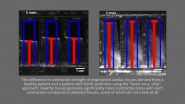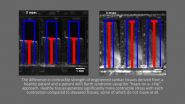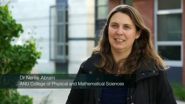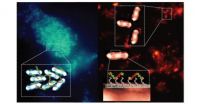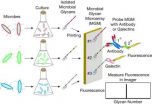(Press-News.org) Cambridge, MA—Harvard scientists have merged stem cell and 'organ-on-a-chip' technologies to grow, for the first time, functioning human heart tissue carrying an inherited cardiovascular disease. The research appears to be a big step forward for personalized medicine, as it is working proof that a chunk of tissue containing a patient's specific genetic disorder can be replicated in the laboratory.
The work, published in Nature Medicine, is the result of a collaborative effort bringing together scientists from the Harvard Stem Cell Institute, the Wyss Institute for Biologically Inspired Engineering, Boston Children's Hospital, the Harvard School of Engineering and Applied Sciences, and Harvard Medical School. It combines the 'organs-on-chips' expertise of Kevin Kit Parker, PhD, and stem cell and clinical insights by William Pu, MD.
Using their interdisciplinary approach, the investigators modeled the cardiovascular disease Barth syndrome, a rare X-linked cardiac disorder caused by mutation of a single gene called Tafazzin, or TAZ. The disorder, which is currently untreatable, primarily appears in boys, and is associated with a number of symptoms affecting heart and skeletal muscle function.
The researchers took skin cells from two Barth syndrome patients, and manipulated the cells to become stem cells that carried these patients' TAZ mutations. Instead of using the stem cells to generate single heart cells in a dish, the cells were grown on chips lined with human extracellular matrix proteins that mimic their natural environment, tricking the cells into joining together as they would if they were forming a diseased human heart. The engineered diseased tissue contracted very weakly, as would the heart muscle seen in Barth syndrome patients.
The investigators then used genome editing—a technique pioneered by Harvard collaborator George Church, PhD—to mutate TAZ in normal cells, confirming that this mutation is sufficient to cause weak contraction in the engineered tissue. On the other hand, delivering the TAZ gene product to diseased tissue in the laboratory corrected the contractile defect, creating the first tissue-based model of correction of a genetic heart disease.
"You don't really understand the meaning of a single cell's genetic mutation until you build a huge chunk of organ and see how it functions or doesn't function," said Parker, who has spent over a decade working on 'organs-on-chips' technology. "In the case of the cells grown out of patients with Barth syndrome, we saw much weaker contractions and irregular tissue assembly. Being able to model the disease from a single cell all the way up to heart tissue, I think that's a big advance."
Furthermore, the scientists discovered that the TAZ mutation works in such a way to disrupt the normal activity of mitochondria, often called the power plants of the cell for their role in making energy. However, the mutation didn't seem to affect overall energy supply of the cells. In what could be a newly identified function for mitochondria, the researchers describe a direct link between mitochondrial function and a heart cell's ability to build itself in a way that allows it to contract.
VIDEO:
The difference in contractile strength of engineered cardiac tissues derived from a healthy patient and a patient with Barth syndrome using the "heart-on-a -chip " approach. Healthy tissues generate significantly more...
Click here for more information.
"The TAZ mutation makes Barth syndrome cells produce an excess amount of reactive oxygen species or ROS—a normal byproduct of cellular metabolism released by mitochondria—which had not been recognized as an important part of this disease," said Pu, who cares for patients with the disorder.
"We showed that, at least in the laboratory, if you quench the excessive ROS production then you can restore contractile function," Pu added. "Now, whether that can be achieved in an animal model or a patient is a different story, but if that could be done, it would suggest a new therapeutic angle."
His team is now trying to translate this finding by doing ROS therapy and gene replacement therapy in animal models of Barth syndrome to see if anything could potentially help human patients. At the same time, the scientists are using their human 'heart disease-on-a-chip' as a testing platform for drugs that are potentially under trial or already approved that might be useful to treat the disorder.
"We tried to thread multiple needles at once and it certainly paid off," Parker said. "I feel that the technology that we've got arms industry and university-based researchers with the tools they need to go after this disease."
Both Parker and Pu, who first talked about collaborating at a 2012 Stockholm conference, credit their partnership and scientific consilience for the success of this research. Parker asserted that the 'organs-on-chips' technology that has been a flagship of his lab only worked so fast and well because of the high quality of Pu's patient-derived cardiac cells.
"When we first got those cells down on the chip, Megan, one of the joint first authors, texted me 'this is working,'" he recalled. "We thought we'd have a much harder fight."
"When I'm asked what's unique about being at Harvard, I always bring up this story," Pu said. "The diverse set of people and cutting-edge technology available at Harvard certainly made this study possible."
INFORMATION:
The researchers also involved in this work include: Joint first authors Gang Wang, MD, of Boston Children's Hospital, and Megan McCain, PhD, who earned her degree at the Harvard School of Engineering and Applied Sciences and is now an assistant professor at the University of Southern California. Amy Roberts, MD, of Boston Children's Hospital, and Richard Kelley, MD, PhD, at the Kennedy Krieger Institute provided patient data and samples, and Frédéric Vaz, PhD, and his team at the Academic Medical Center in the Netherlands conducted additional analyses. Technical protocols were shared by Kenneth Chien, MD, PhD, at the Karolinska Institutet.
Kevin Kit Parker, PhD, is the Tarr Family Professor of Bioengineering and Applied Physics in Harvard's School of Engineering and Applied Sciences, a Core Faculty member of the Wyss Institute for Biologically Inspired Engineering, and a Principal Faculty member of the Harvard Stem Cell Institute.
William Pu, MD, is an Associate Professor at Harvard Medical School, a member of the Department of Cardiology at Boston Children's Hospital, and an Affiliated Faculty member of the Harvard Stem Cell Institute.
George Church, PhD, is a Professor of Genetics at Harvard Medical School and a Core Faculty member of the Wyss Institute of Biologically Inspired Engineering.
The work was supported by the Barth Syndrome Foundation, Boston Children's Hospital, the National Institutes of Health, and charitable donations from Edward Marram, Karen Carpenter, and Gail Federici Smith.
Cited: Wang, G., McCain, M., et. al. Modeling the mitochondrial cardiomyopathy of Barth syndrome with iPSC and heart-on-a-chip technologies. Nature Medicine. May 11, 2014
Patient stem cells used to make 'heart disease-on-a-chip'
Cross-Harvard collaboration explores new possibilities for personalized medicine
2014-05-11
ELSE PRESS RELEASES FROM THIS DATE:
Ocean winds keep Antarctica cold, Australia dry
2014-05-11
VIDEO:
Dr. Nerlie Abram, from the Australian National University, explains why ocean winds have stopped Antarctica from warming as much as other continents. Her research also explains droughts in Southern Australia.
Click here for more information.
New Australian National University-led research has explained why Antarctica is not warming as much as other continents, and why southern Australia is recording more droughts.
Researchers have found rising levels of carbon dioxide ...
Hijacking bacteria's natural defences to trap and reveal pathogens
2014-05-11
The breakthrough, published in the journal Nature Materials, could offer an easier way of detecting pathogenic bacteria outside of a clinical setting and could be particularly important for the developing world, where access to more sophisticated laboratory techniques is often limited.
The research was led by Professor Cameron Alexander, Head of the Division of Drug Delivery and Tissue Engineering and EPSRC Leadership Fellow in the University's School of Pharmacy, building on work by PhD student Peter Magennis. Professor Alexander said: "Essentially, we have hijacked ...
UGA research examines fate of methane following the Deepwater Horizon spill
2014-05-11
Athens, Ga. – The 2010 Deepwater Horizon blowout discharged roughly five million gallons of oil and up to 500,000 tons of natural gas into Gulf of Mexico offshore waters over a period of 84 days. In the face of a seemingly insurmountable cleanup effort, many were relieved by reports following the disaster that naturally-occurring microbes had consumed much of the gas and oil.
Now, a team of researchers led by University of Georgia marine scientists have published a paper in the journal Nature Geoscience that questions this conclusion and provides evidence that microbes ...
Galectins direct immunity against bacteria that employ camouflage
2014-05-11
Our bodies produce a family of proteins that recognize and kill bacteria whose carbohydrate coatings resemble those of our own cells too closely, scientists have discovered.
Called galectins, these proteins recognize carbohydrates from a broad range of disease-causing bacteria, and could potentially be deployed as antibiotics to treat certain infections. The results are scheduled for publication in Nature Chemical Biology.
Researchers at Emory University School of Medicine made the discovery with the aid of glass slides coated with an array of over 300 different glycans ...
Study finds patients AFib at higher risk of dementia when meds out of range
2014-05-10
A new study by researchers at the Intermountain Medical Center Heart Institute in Salt Lake City has found that atrial fibrillation patients who are on blood thinning medications are at higher risk of developing dementia if their doses are not in the optimal recommended range.
The study of more than 2,600 AFib patients found they are significantly more likely to develop dementia when using medicines to prevent blood clots, such as warfarin, when their dosing is too high or too low for an extended period of time.
Findings from the study will be presented at the 2014 ...
Bee biodiversity boosts crop yields
2014-05-10
Research from North Carolina State University shows that blueberries produce more seeds and larger berries if they are visited by more diverse bee species, allowing farmers to harvest significantly more pounds of fruit per acre.
"We wanted to understand the functional role of diversity," says Dr. Hannah Burrack, an associate professor of entomology at NC State and co-author of a paper on the research. "And we found that there is a quantifiable benefit of having a lot of different types of bees pollinating a crop."
The researchers looked at blueberries in North Carolina ...
Scientists find gene behind a highly prevalent facial anomaly
2014-05-10
CAMBRIDGE, Mass. (May 9, 2014) – Whitehead Institute scientists have identified a genetic cause of a facial disorder known as hemifacial microsomia (HFM). The researchers find that duplication of the gene OTX2 induces HFM, the second-most common facial anomaly after cleft lip and palate.
HFM affects approximately one in 3,500 births. While some cases appear to run in families, no gene had been found to be causative. That is until Whitehead Fellow Yaniv Erlich and his lab set out to do just that. Their work is described in this week's issue of the journal PLOS ONE.
Patients ...
Cardiac screening test may help determine who should take aspirin to prevent heart attack
2014-05-09
MINNEAPOLIS, MN – May 6, 2014 – For over 30 years, aspirin has been known to prevent heart attacks and strokes, but who exactly should take a daily aspirin remains unclear. New research published today in Circulation: Cardiovascular Quality and Outcomes shows that your coronary artery calcium (CAC) score, a measurement of plaque in the arteries that feed the heart, may help determine whether or not you are a good candidate for aspirin.
"Many heart attacks and strokes occur in individuals who do not appear to be at high risk," states lead author, Michael D Miedema, MD, ...
NASA's TRMM Satellite see spring storms hit the US Great Plains
2014-05-09
VIDEO:
The TRMM satellite flew above tornado spawning thunderstorms in the southern United States on May 9, 2014 at 0115 UTC. This simulated 3-D TRMM animation shows the location of intense...
Click here for more information.
The Tropical Rainfall Measuring Mission or TRMM satellite captured rainfall and cloud height information about the powerful thunderstorms and severe weather that affected the Great Plains over May 8 and 9.
Severe weather extended from Minnesota to southern ...
Plugging leaky blood vessels to save vision
2014-05-09
TORONTO – A new drug approach has been developed for safer clean-up of deformed blood vessels in the eye by a research team at the Lunenfeld-Tanenbaum Research Institute, Mount Sinai Hospital in Toronto.
The growth of malformed blood vessels that can burst is a leading cause of vision loss in North America. Retinopathy and retina degeneration are associated with premature birth, with diabetes, and with increasing age.
Research just published by Dr. Andras Nagy and co-authors shows both safety and effectiveness in their bioengineered compound when treating retinopathy ...
LAST 30 PRESS RELEASES:
Making lighter work of calculating fluid and heat flow
Normalizing blood sugar can halve heart attack risk
Lowering blood sugar cuts heart attack risk in people with prediabetes
Study links genetic variants to risk of blinding eye disease in premature infants
Non-opioid ‘pain sponge’ therapy halts cartilage degeneration and relieves chronic pain
AI can pick up cultural values by mimicking how kids learn
China’s ecological redlines offer fast track to 30 x 30 global conservation goal
Invisible indoor threats: emerging household contaminants and their growing risks to human health
Adding antibody treatment to chemo boosts outcomes for children with rare cancer
Germline pathogenic variants among women without a history of breast cancer
Tanning beds triple melanoma risk, potentially causing broad DNA damage
Unique bond identified as key to viral infection speed
Indoor tanning makes youthful skin much older on a genetic level
Mouse model sheds new light on the causes and potential solutions to human GI problems linked to muscular dystrophy
The Journal of Nuclear Medicine ahead-of-print tip sheet: December 12, 2025
Smarter tools for peering into the microscopic world
Applications open for funding to conduct research in the Kinsey Institute archives
Global measure underestimates the severity of food insecurity
Child survivors of critical illness are missing out on timely follow up care
Risk-based vs annual breast cancer screening / the WISDOM randomized clinical trial
University of Toronto launches Electric Vehicle Innovation Ontario to accelerate advanced EV technologies and build Canada’s innovation advantage
Early relapse predicts poor outcomes in aggressive blood cancer
American College of Lifestyle Medicine applauds two CMS models aligned with lifestyle medicine practice and reimbursement
Clinical trial finds cannabis use not a barrier to quitting nicotine vaping
Supplemental nutrition assistance program policies and food insecurity
Switching immune cells to “night mode” could limit damage after a heart attack, study suggests
URI-based Global RIghts Project report spotlights continued troubling trends in worldwide inhumane treatment
Neutrophils are less aggressive at night, explaining why nighttime heart attacks cause less damage than daytime events
Menopausal hormone therapy may not pose breast cancer risk for women with BRCA mutations
Mobile health tool may improve quality of life for adolescent and young adult breast cancer survivors
[Press-News.org] Patient stem cells used to make 'heart disease-on-a-chip'Cross-Harvard collaboration explores new possibilities for personalized medicine
